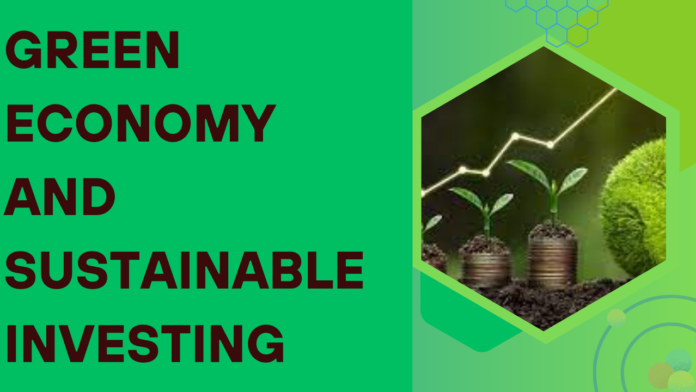Introduction to Green Economy and Sustainable Investing
The world is at a pivotal juncture, where economic growth and environmental health are no longer seen as opposing forces but rather as partners in progress. As we navigate through climate change challenges and resource depletion, the concept of a green economy has emerged as a beacon of hope. This shift not only emphasizes sustainability but also presents unique investment opportunities that align with environmental stewardship.
More investors are recognizing the importance of sustainable investing, merging profits with purpose. From solar energy to waste reduction technologies, the potential for financial growth while fostering ecological balance is enormous. Join us on this journey to explore how embracing a green economy can lead to innovative solutions and meaningful returns on investments—both for your portfolio and our planet’s future.
The Importance of Environmental Sustainability
Environmental sustainability is crucial for maintaining the planet’s health. As our population grows, so do the demands on natural resources. Without a sustainable approach, we risk depleting these vital assets.
Preserving ecosystems ensures biodiversity thrives. Each species plays a role in its habitat, contributing to ecological balance. When one element falters, it can lead to cascading effects throughout the environment.
Furthermore, environmental sustainability directly impacts human well-being. Clean air and water are fundamental to our health and quality of life. By protecting our surroundings, we safeguard future generations from pollution-related diseases.
Economic stability also hinges on sustainable practices. Industries that prioritize environmental responsibility often thrive in today’s market where consumers favor ethical choices.
Investing in renewable energy sources not only reduces carbon footprints but fosters innovation and job creation too. A proactive stance now paves the way for a prosperous and resilient future for all inhabitants of Earth.
What is a Green Economy?
A green economy is one that prioritizes environmental health while promoting economic growth. It focuses on sustainable practices that lead to resource efficiency and reduced carbon emissions.
In this model, businesses aim to balance profit with ecological preservation. This means investing in renewable energy sources, like solar and wind power, instead of relying solely on fossil fuels.
Job creation in sectors such as clean technology and sustainable agriculture also plays a crucial role. The green economy encourages innovation that addresses climate change challenges without sacrificing economic progress.
It’s about reshaping industries so they can thrive alongside nature rather than at its expense. By fostering sustainability, the green economy aims for long-term resilience against environmental degradation and social inequities. This approach reflects a commitment to preserving the planet for future generations while enhancing current living standards.
Understanding Sustainable Investing
Sustainable investing is more than just a trend; it’s a commitment to creating positive environmental impact while seeking financial returns. Investors are increasingly looking for opportunities that align with their values.
This approach focuses on businesses and projects that prioritize sustainability. It considers factors like environmental, social, and governance (ESG) criteria. By evaluating these elements, investors can identify companies making strides toward greener practices.
Investing in sustainable initiatives helps address climate change and promotes responsible resource management. It encourages innovation in renewable energy, waste reduction, and ethical supply chains.
The landscape of sustainable investing is diverse. From green bonds to ESG-focused funds, options abound for those wanting to invest responsibly. This evolution reflects a shift in consumer preferences and the growing recognition of long-term benefits linked to sustainability efforts.
Benefits of Investing in the Green Economy
Investing in the green economy presents a host of benefits that extend beyond financial gains. One significant advantage is alignment with global sustainability goals. Investors contribute to initiatives that combat climate change and promote environmental stewardship.
There’s also the potential for long-term returns. As more companies adopt sustainable practices, their market positioning strengthens, often resulting in increased profitability over time.
Additionally, investing in renewable energy projects can lead to job creation within local communities. This boosts economic resilience while fostering innovation across various sectors.
Another key benefit is the growing consumer demand for sustainable products and services. Companies focused on eco-friendly solutions are likely to attract loyal customers who prioritize ethical consumption.
Incorporating ESG (Environmental, Social, Governance) factors into investment strategies can enhance portfolio diversification. This approach helps mitigate risks associated with traditional investments linked to fossil fuels or other environmentally harmful industries.
Risks and Challenges of Sustainable Investing
Sustainable investing presents a set of unique risks and challenges that investors must navigate. One significant concern is the lack of standardized metrics to assess ESG (Environmental, Social, and Governance) criteria across industries. This inconsistency can lead to confusion when comparing investment options.
Market volatility also poses a challenge. The green economy may experience fluctuations due to regulatory changes or shifts in public sentiment. These factors can impact stock prices for companies focused on sustainability.
Additionally, there’s the risk of “greenwashing.” Some firms might overstate their commitment to sustainable practices without genuine follow-through. Investors need thorough diligence to sift through marketing claims.
Illiquidity can be an issue with certain renewable energy projects or startups within the green economy space. These investments often require longer time horizons before yielding returns, which might not align with every investor’s strategy or needs.
How to Get Started with Sustainable Investing
Getting started with sustainable investing is easier than you might think. Begin by identifying your values and priorities. What environmental or social issues matter most to you? This will help guide your investment choices.
Next, research investment options that align with a green economy. Look for funds or companies focused on renewable energy, clean technology, or socially responsible practices. Resources like the Morgan Stanley Institute for Sustainable Investing can provide valuable insights.
Consider using ESG criteria to evaluate potential investments. These guidelines assess how companies perform in terms of environmental impact, social responsibility, and governance practices.
Start small if necessary. Many platforms allow you to invest with minimal amounts of capital. Over time, as your confidence grows, diversify your portfolio across various sectors within the green economy.
Stay informed about trends and developments in climate finance solutions to make educated decisions that resonate with your sustainable goals.
Case Studies: Companies thriving in the Green Economy
Several companies are leading the charge in the green economy, showcasing innovative approaches to sustainability.
Patagonia stands out with its commitment to environmental activism. The brand not only produces sustainable outdoor gear but also pledges 1% of sales to environmental causes. Their transparent supply chain has set a benchmark for corporate responsibility.
Next, we have Tesla, revolutionizing transportation through electric vehicles. With a focus on renewable energy solutions and battery technology, they are transforming how we think about personal and commercial mobility.
Seventh Generation is another example, offering eco-friendly household products made from plant-based ingredients. Their mission emphasizes sustainability at every step of production, highlighting responsible consumerism.
These companies illustrate that thriving in a green economy isn’t just possible; it’s profitable and essential for future growth while contributing positively to the planet’s health.
Conclusion: Why the Future is Green
The path forward is undeniably green. As the world grapples with pressing environmental challenges, a shift towards sustainable practices in both our economy and investment strategies becomes essential. The green economy isn’t just an alternative; it’s becoming the standard for future business operations and financial decisions.
Investing in a green economy not only addresses climate change but also opens doors to innovative opportunities. Companies that prioritize sustainability are likely to thrive as consumers demand more responsible products and services. This trend will drive substantial growth in sectors focused on renewable energy, waste management, and eco-friendly technologies.
Moreover, the rise of ESG investments highlights how investors are increasingly considering environmental factors when making decisions. This evolution reflects a growing awareness that long-term success relies on sustainable practices.
As you consider your own investing journey, remember that aligning your portfolio with environmentally conscious companies can lead to positive impacts—both financially and socially. Embracing this approach benefits not just individual investors but society at large.
With every step taken toward embracing sustainability through finance, we pave the way for healthier communities and a safer planet for generations to come. A brighter tomorrow hinges upon our commitment today—join the movement toward a vibrant green economy where progress meets responsibility.


